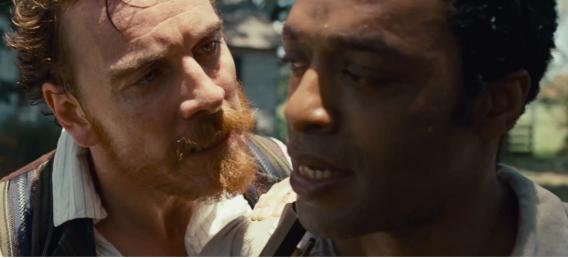12 Years a slave
Among movies about race in America, how many great films have been made about slavery? We’ve seen gentle drivers (“Driving Miss Daisy”), sisterhoods of maids (“The Help”) and pizza places going up in smoke for our sins (“Do the Right Thing”). Most of these films focus on the sixties or the modern day. Even Lincoln barely touches on slavery as more than legal theory.
This enormous, shocking gap has been filled movingly by Steve McQueen’s “12 Years a Slave” (a likely breakthrough for a terrific director). The film is based on an 1853 memoir of a free black violinist (Chiwetel Ejiofor) who was kidnapped from his New York family and sold into slavery in Louisiana. He first goes to a relatively livable plantation (given the other choices) where his master (Benedict Cumberbatch) values his talents, but ends on a poor cotton farm with a tyrannical slave owner (Michael Fassbender).
Never short on cruel truths, “12 Years” does not spare the hard, human labor, dry throats, the sting of a whip on skin. Ejiofor traps us in the reality of suffering, of being property, of living near death. The first question about slavery isn’t only how slaves survived these conditions. It is how any society could live willingly with so much torture around them. And how much human potential was wasted in the fields.
As a history buff I’ve read more about the reality of slavery than many. “12 Years a Slave” plays a great deal like ‘The Autobiography of Frederick Douglass’ (How long until this is made into a film?). Textbooks might overlook some cruelties––rape, being one of them––that are told here, and will be new to some. Both books also emphasize the fear of literacy and knowledge among slaves. Knowing the alphabet is a life-threatening risk.
These works are best when they are not only about slavery, but the surprising complexity of the social relations of the era. “12 Years” stands out for the allowance it gives to the men and women, white and black, to show decency or spite. Some – Brad Pitt’s abolitionist – rise. Others – Cumberbatch – have their human decency swallowed by the system. Others still – Paul Dano’s foreman, Fassbender’s villainous slaveowner – feel empowered by the evil.
Even in showing human complexity, “12 Years A Slave” never flinches from portraying slavery as the great national sickness. This is no more as Solomon waits in an underground prison underneath Washington D.C. The camera pulls back to include a long shot of the Washington skyline of the time, with the U.S. Capitol across the skyline of the time. It’s a stark reminder that this happened here, against our ideals–and not that long ago.





